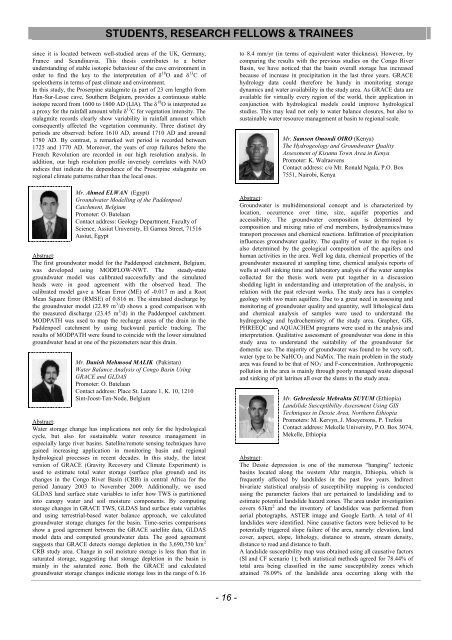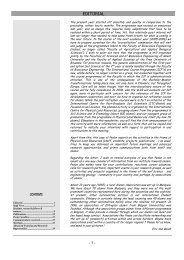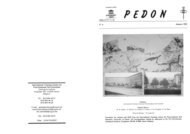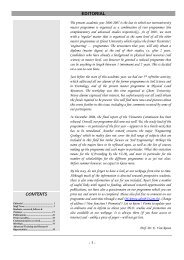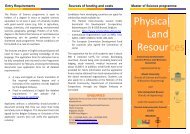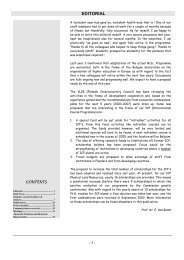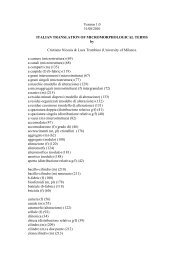Pedon 23 - Physical Land Resources - Universiteit Gent
Pedon 23 - Physical Land Resources - Universiteit Gent
Pedon 23 - Physical Land Resources - Universiteit Gent
Create successful ePaper yourself
Turn your PDF publications into a flip-book with our unique Google optimized e-Paper software.
STUDENTS, RESEARCH FELLOWS & TRAINEES<br />
since it is located between well-studied areas of the UK, Germany,<br />
France and Scandinavia. This thesis contributes to a better<br />
understanding of stable isotopic behaviour of the cave environment in<br />
order to find the key to the interpretation of δ 18 O and δ 13 C of<br />
speleothems in terms of past climate and environment.<br />
In this study, the Proserpine stalagmite (a part of <strong>23</strong> cm length) from<br />
Han-Sur-Lesse cave, Southern Belgium, provides a continuous stable<br />
isotope record from 1600 to 1800 AD (LIA). The δ 18 O is interpreted as<br />
a proxy for the rainfall amount while δ 13 C for vegetation intensity. The<br />
stalagmite records clearly show variability in rainfall amount which<br />
consequently affected the vegetation community. Three distinct dry<br />
periods are observed: before 1610 AD, around 1710 AD and around<br />
1780 AD. By contrast, a remarked wet period is recorded between<br />
1725 and 1770 AD. Moreover, the years of crop failures before the<br />
French Revolution are recorded in our high resolution analysis. In<br />
addition, our high resolution profile inversely correlates with NAO<br />
indices that indicate the dependence of the Proserpine stalagmite on<br />
regional climate patterns rather than the local ones.<br />
Mr. Ahmed ELWAN (Egypt)<br />
Groundwater Modelling of the Paddenpoel<br />
Catchment, Belgium<br />
Promoter: O. Batelaan<br />
Contact address: Geology Department, Faculty of<br />
Science, Assiut University, El Gamea Street, 71516<br />
Assiut, Egypt<br />
Abstract:<br />
The first groundwater model for the Paddenpoel catchment, Belgium,<br />
was developed using MODFLOW-NWT. The steady-state<br />
groundwater model was calibrated successfully and the simulated<br />
heads were in good agreement with the observed head. The<br />
calibrated model gave a Mean Error (ME) of -0.017 m and a Root<br />
Mean Square Error (RMSE) of 0.816 m. The simulated discharge by<br />
the groundwater model (22.89 m 3 /d) shows a good comparison with<br />
the measured discharge (<strong>23</strong>.45 m 3 /d) in the Paddenpoel catchment.<br />
MODPATH was used to map the recharge areas of the drain in the<br />
Paddenpoel catchment by using backward particle tracking. The<br />
results of MODPATH were found to coincide with the lower simulated<br />
groundwater head at one of the piezometers near this drain.<br />
Mr. Danish Mehmood MALIK (Pakistan)<br />
Water Balance Analysis of Congo Basin Using<br />
GRACE and GLDAS<br />
Promoter: O. Batelaan<br />
Contact address: Place St. Lazare 1, K. 10, 1210<br />
Sint-Joost-Ten-Node, Belgium<br />
Abstract:<br />
Water storage change has implications not only for the hydrological<br />
cycle, but also for sustainable water resource management in<br />
especially large river basins. Satellite/remote sensing techniques have<br />
gained increasing application in monitoring basin and regional<br />
hydrological processes in recent decades. In this study, the latest<br />
version of GRACE (Gravity Recovery and Climate Experiment) is<br />
used to estimate total water storage (surface plus ground) and its<br />
changes in the Congo River Basin (CRB) in central Africa for the<br />
period January 2003 to November 2009. Additionally, we used<br />
GLDAS land surface state variables to infer how TWS is partitioned<br />
into canopy water and soil moisture components. By computing<br />
storage changes in GRACE TWS, GLDAS land surface state variables<br />
and using terrestrial-based water balance approach, we calculated<br />
groundwater storage changes for the basin. Time-series comparisons<br />
show a good agreement between the GRACE satellite data, GLDAS<br />
model data and computed groundwater data. The good agreement<br />
suggests that GRACE detects storage depletion in the 3,690,750 km 2<br />
CRB study area. Change in soil moisture storage is less than that in<br />
saturated storage, suggesting that storage depletion in the basin is<br />
mainly in the saturated zone. Both the GRACE and calculated<br />
groundwater storage changes indicate storage loss in the range of 6.16<br />
to 8.4 mm/yr (in terms of equivalent water thickness). However, by<br />
comparing the results with the previous studies on the Congo River<br />
Basin, we have noticed that the basin overall storage has increased<br />
because of increase in precipitation in the last three years. GRACE<br />
hydrology data could therefore be handy in monitoring storage<br />
dynamics and water availability in the study area. As GRACE data are<br />
available for virtually every region of the world, their application in<br />
conjunction with hydrological models could improve hydrological<br />
studies. This may lead not only to water balance closures, but also to<br />
sustainable water resource management at basin to regional scale.<br />
Mr. Samson Omondi OIRO (Kenya)<br />
The Hydrogeology and Groundwater Quality<br />
Assessment of Kisumu Town Area in Kenya<br />
Promoter: K. Walraevens<br />
Contact address: c/o Mr. Ronald Ngala, P.O. Box<br />
7551, Nairobi, Kenya<br />
Abstract:<br />
Groundwater is multidimensional concept and is characterized by<br />
location, occurrence over time, size, aquifer properties and<br />
accessibility. The groundwater composition is determined by<br />
composition and mixing ratio of end members, hydrodynamics/mass<br />
transport processes and chemical reactions. Infiltration of precipitation<br />
influences groundwater quality. The quality of water in the region is<br />
also determined by the geological composition of the aquifers and<br />
human activities in the area. Well log data, chemical properties of the<br />
groundwater measured at sampling time, chemical analysis reports of<br />
wells at well sinking time and laboratory analysis of the water samples<br />
collected for the thesis work were put together in a discussion<br />
shedding light in understanding and interpretation of the analysis, in<br />
relation with the past relevant works. The study area has a complex<br />
geology with two main aquifers. Due to a great need in assessing and<br />
monitoring of groundwater quality and quantity, well lithological data<br />
and chemical analysis of samples were used to understand the<br />
hydrogeology and hydrochemistry of the study area. Grapher, GIS,<br />
PHREEQC and AQUACHEM programs were used in the analysis and<br />
interpretation. Qualitative assessment of groundwater was done in this<br />
study area to understand the suitability of the groundwater for<br />
domestic use. The majority of groundwater was found to be very soft,<br />
water type to be NaHCO 3 and NaMix. The main problem in the study<br />
area was found to be that of NO 3 - and F-concentration. Anthropogenic<br />
pollution in the area is mainly through poorly managed waste disposal<br />
and sinking of pit latrines all over the slums in the study area.<br />
Mr. Gebreslassie Mebrahtu SUYUM (Ethiopia)<br />
<strong>Land</strong>slide Susceptibility Assessment Using GIS<br />
Techniques in Dessie Area, Northern Ethiopia<br />
Promoters: M. Kervyn, J. Moeyersons, P. Trefois<br />
Contact address: Mekelle University, P.O. Box 3074,<br />
Mekelle, Ethiopia<br />
Abstract:<br />
The Dessie depression is one of the numerous “hanging” tectonic<br />
basins located along the western Afar margin, Ethiopia, which is<br />
frequently affected by landslides in the past few years. Indirect<br />
bivariate statistical analysis of susceptibility mapping is conducted<br />
using the parameter factors that are pertained to landsliding and to<br />
estimate potential landslide hazard zones. The area under investigation<br />
covers 63km 2 and the inventory of landslides was performed from<br />
aerial photographs, ASTER image and Google Earth. A total of 41<br />
landslides were identified. Nine causative factors were believed to be<br />
potentially triggered slope failure of the area, namely: elevation, land<br />
cover, aspect, slope, lithology, distance to stream, stream density,<br />
distance to road and distance to fault.<br />
A landslide susceptibility map was obtained using all causative factors<br />
(SI and CF scenario 1); both statistical methods agreed for 78.44% of<br />
total area being classified in the same susceptibility zones which<br />
attained 78.09% of the landslide area occurring along with the<br />
- 16 -


